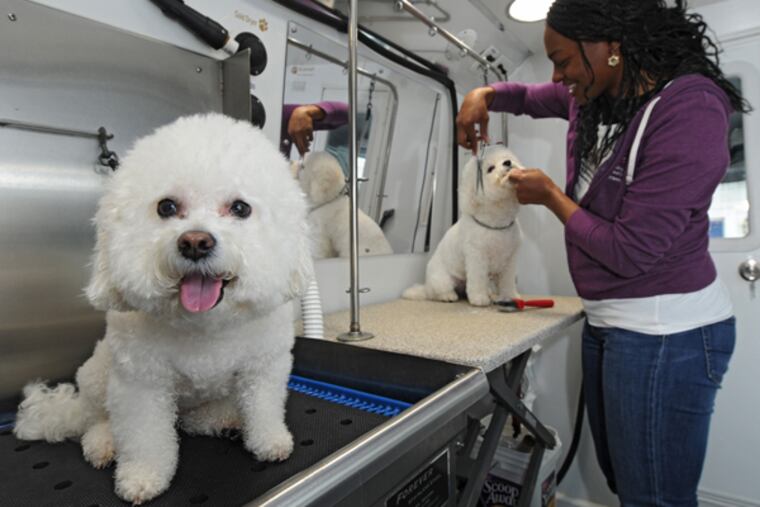Looking for the best pet groomers in the Philadelphia region? Here’s a search tool for that
Through a special arrangement, The Inquirer readers can access Delaware Valley Consumer Checkbook’s ratings of area pet groomers for free through March 5.

You rely on your favorite salon for hair trims and the neighborhood pedi-parlor for twice-a-month manicures. Groomers offer similar maintenance for your pooch — untangling matted fur, banishing stinky odors with shampoo, and trimming your feisty terrier’s nails.
Here are tips from nonprofit Delaware Valley Consumers’ Checkbook on how to find the right groomer, at the right price. Checkbook’s ratings of area groomers will steer you to the best operations. Through a special arrangement, Inquirer readers can access Checkbook’s ratings of area pet groomers for free through March 5 by visiting Checkbook.org/Inquirer/Groomers.
How often your dog needs to be groomed depends on breed, size, type of coat, and your own standards. Professional groomers argue that all pooches benefit from regular visits because this helps maintain their overall health. This is, of course, a self-serving claim, but there’s some truth in it: Consistent grooming improves hygiene and also means Fido will be periodically inspected by someone who sees a lot of dogs and can spot potential health problems.
Be aware that, for some breeds, there is such a thing as too much grooming. Too-frequent baths can remove natural oils in a dog’s coat or skin, causing it to become dry and raw. Before setting a regular grooming schedule, ask your vet how often grooming for your pet is recommended. (Checkbook also rates local veterinary practices for quality and price.)
Compare prices. Even among groomers who are highly recommended by their customers, you’ll find a wide range of pricing. Checkbook’s undercover shoppers surveyed a sample of area grooming outfits for their prices to groom (including haircut) a cocker spaniel and a golden retriever. They were quoted a range from $45 to $85 or more for each of the breeds.
Experience counts. You wouldn’t want your hair cut by someone who’s never done it before. With dog groomers, having many years of experience not only means they have had time to perfect the craft, but also that they’ll be better at assessing dogs’ behavior and responding appropriately to nervousness and agitation. Also ask whether the groomer is familiar with your breed — even highly experienced pet pros won’t have extensive experience with all of them. The best groomers will be upfront about their limitations and, if necessary, direct you to another groomer who knows the breed better.
Check training and credentials. Several organizations certify dog groomers, including the National Dog Groomers Association of America and The International Society of Canine Cosmetologists. Certification from either means a groomer attended classes and then passed a series of written and practical exams. Since the amount of time and effort required for certification is substantial, certification does indicate a groomer is serious about his or her profession and possesses at least the basic skills for the job. On the other hand, many talented, experienced groomers haven’t bothered to take the time or pay the fees to become certified.
Think about, and discuss, your expectations. Do you want basic grooming services, with no concern that your dog’s trim meets exacting breed-specific standards? Or do you have much higher expectations — a scissored haircut, a sculpted trim, or hand stripping for a terrier? Tell prospective groomers what you want, and ask them upfront whether they think they can meet your needs.
Check whether you can be present for the grooming. You’ll learn a lot about how the staff treats your dog and other dogs if you watch groomers in action.
Take a tour. The facility should be neat, tidy, and well-lit. It should not be foul-smelling; a whiff of disinfectant is fine, but a strong chemical odor might be masking a serious mess. If dogs are positioned under blow dryers and left to dry instead of hand-dried, staff should be able to easily monitor the area so dogs do not become overheated or burned. Does staff seem to be knowledgeable and caring? Do they handle and treat the dogs gently and with affection? Are they willing and able to answer any questions you may have?
Check whether they take steps to prevent the spread of disease. Grooming establishments should require all customers to present vaccination records before admitting dogs to their facilities.
Consider the convenience of pickup/drop-off arrangements. Most groomers let customers drop off their dogs in the morning on their way to work and pick them up on their way home. While this arrangement is convenient for most pet owners, it means your dog will have to spend the entire day at the facility — and some dogs do not handle these situations as gracefully as others.
If your dog becomes very upset when visiting a groomer, consider using a mobile grooming operation, which minimizes the amount of time your dog spends out of your home at the groomer’s.
Avoid groomers who sedate animals. Even if your pet is extremely nervous about visiting the groomer, do not let the dog be sedated unless the sedation will be administered by a veterinarian who will then also monitor the dog’s care throughout the stay.
____________________________________________________
Delaware Valley Consumers’ Checkbook magazine (and Checkbook.org) is a nonprofit organization with a mission to help consumers get the best service and lowest prices. We are supported by consumers and take no money from the service providers we evaluate.